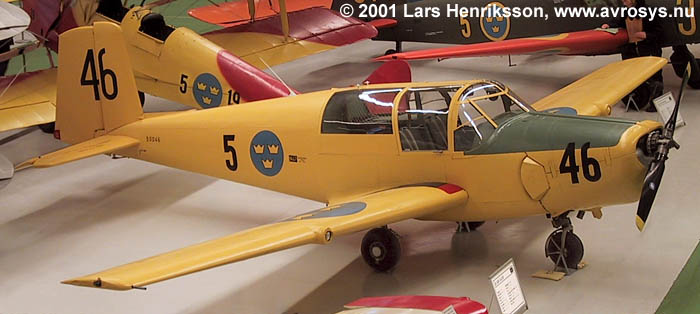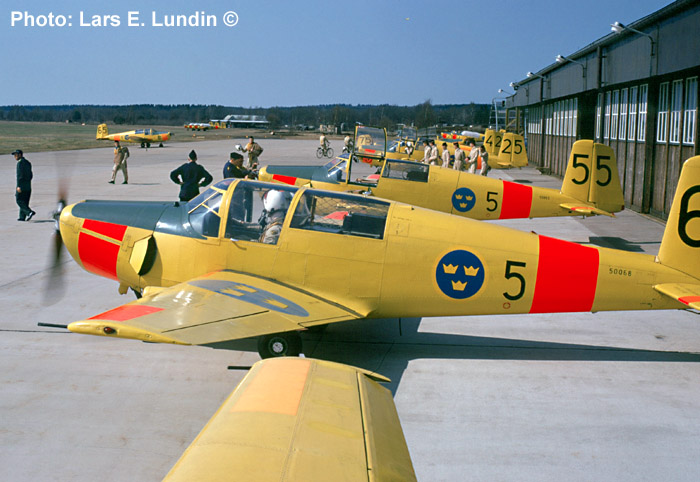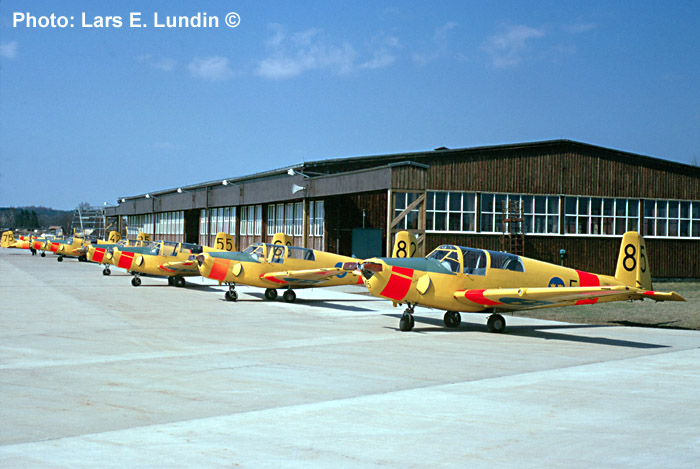|
|
||||
| Sk 50 - SAAB 91B & 91C Safir (1952-1992) | ||||
|
|
Page 1 (3) |
|
||
|
|
||||
 |
||||
|
the end of WWII, SAAB decided to develop three civil products. These
were the SAAB 90 Scandia - a medium airliner, the SAAB 91 Safir and the
car SAAB 92. The first prototype of SAAB 91 Safir (in English ”Sapphire”) flew for the first time at the end of 1945. Chief designer was Anders J. Andersson, who had left Bücker in Germany and returned to Sweden in 1939. Andersson was the brain behind a row of successful trainers built by Bücker Flugzeugbau, of which one, the Sk 25 Bücker 181B-1 Bestmann was built under licence in Sweden. You will easily see some exterior resemblance of the Bestmann compared with the Safir. But the Safir is an aircraft built in a light metal shell construction (except for control surfaces and aft part of the wings) and has a retractable landing gear with nose wheel.
The
Air Force ordered ten Safirs of the first variant 91A in 1946. They were
designated as transport aircraft (Tp
91) and were used for liaison purposes. To the disappointment of
SAAB, the Air Force did not regard the 91A as a suitable trainer. Too
less power, too narrow cabin and too weak structurally.
To
fulfil the demands of the Air Force, SAAB in 1949 developed a more
powerful version, the 91B, with modified a cockpit and canopy. It was
powered by a six-cylinder Lycoming O-435-A engine of 190 hp. The
aircraft was intensively tested by the Air Board.
Now the Air Force got another opinion of the Safir’s
suitability as a trainer. 75 91Bs was ordered and got the designation SK
50B.
In
this year, in the shadow of the beginning cold war, SAAB used all of its
production capacity for building the J 29 ”Flygande tunnan” fighter
aircraft for the Air Force. SAAB looked for a subcontractor to produce
the SK 50B. An agreement was made with De Schelde at Dortrecht in the
Netherlands, a subsidiary to Fokker. 120 of the totally 323 Safirs
produced were built in the Netherlands. In 1955/56 the production was
moved back to Sweden.
The
Sk 50B’s were delivered to F 5 (the Air Force Flight Academy) at Ljungbyhed
1952-1954. In 1958, the Air Force ordered 14 of the new Safir 91C
variant, SK 50 C in the Air
Force.
The
main difference between SK 50B and SK 50C was that the
former were three-seated and the latter four-seated. To achieve this,
the large fuselage fuel tank was replaced by wing tanks.
In
1972, the SK 50 was replaced by the SK 61 Bulldog as basic trainer. The
Safirs were transferred to the Air Force Wings all around the country as
liaison aircraft. The last Safir was written off from the Air Force in
1993. Many were sold for a symbolic sum of money to flying clubs at the
Air Force bases.
The
SAAB Safir was sold to 20 countries and served as military trainers in
the Swedish, Finnish, Norwegian, Ethiopian, Austrian and Tunisian air
forces. The aircraft was also used by the flying schools of the airlines
KLM, Sabena, Lufthansa and Air France.
SAAB
201 and SAAB 202 were Safirs fitted with wings for the fighter J 29
”Tunnan” and the attack aircraft A 32 Lansen respectively in half
scale to give valuable aerodynamic data for developing these aircraft. Photo at top: the last Safir in the Air Force, # 50045, now on display at Flygvapenmuseum. SK 50B: Length: 7,90 m. Span: 10,62 m. MTOW: 1.165 kg. Max. speed: 270 km/h.
|
|
|||
 |
||||
|
The Air Force School at Ljungbyhed in
May 1970. |
||||
 |
||||
|
SAAB Safirs
at Ljungbyhed in May 1970. |
||||
|
|
||||
|
|
||||
|
|
||||
|
© Lars Henriksson |
|
Updated 2010-03-21 |
||
|
Custom Search
|
||||